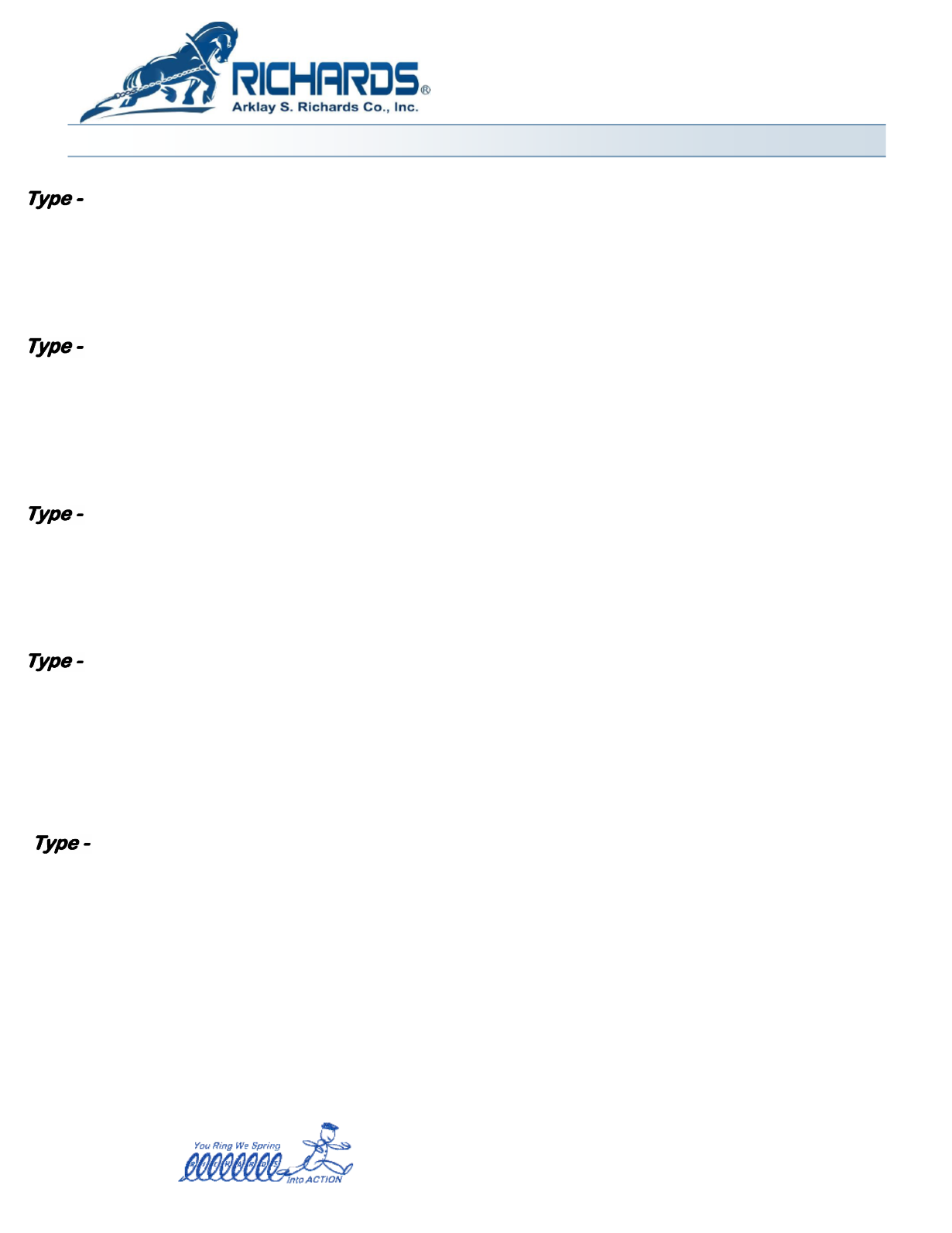

The Type E thermocouple is composed of a Nickel-10% Chromium (+) verses a Nickel-45% Copper (-) wire. This
type of thermocouple can be used in oxidizing or inert atmospheres with a service temperature range of –200 to 900°
C (-330 to 1600°F). The Type E thermocouple can be successfully in subzero applications due to high corrosion re-
sistance to high moisture environments. Out of all the different types of thermocouples, the Type E has the highest
EMF out put per degree.
E
B
The Type C thermocouple is composed of a Tungsten-5% Rhenium (+) wire verses Tungsten-26% Rhenium (-)
wire. This type of thermocouple can be used in high temperature vacuum or inert atmospheres with a service range
up to 2316°C (4200°F). It has very poor oxidation resistance, which must be taken into consideration. The Type C
thermocouple is the most common Tungsten-Rhenium form of thermocouple due to the conductors being the least
brittle at room temperature. This characteristic is very important since brittle conductors create inferior thermocou-
ples. The Type C thermocouple is composed of a Tungsten-5% Rhenium (+) wire verses Tungsten-26% Rhenium (-
) wire. This type of thermocouple can be used in high temperature vacuum or inert atmospheres with a service range
up to 2316°C (4200°F). It has very poor oxidation resistance, which must be taken into consideration. The Type C
thermocouple is the most common Tungsten-Rhenium form of thermocouple due to the conductors being the least
brittle at room temperature. This characteristic is very important since brittle conductors create inferior thermocou-
ples.
C
J
The Type J thermocouple is composed of an Iron (+) wire verses a Nickel-45% Copper wire. This type of thermocou-
ple should be use in oxidizing, reducing, vacuum, or inert atmospheres with a service temperature range between 0
and 760°C (32 to 1400°F). If the thermocouple is being used over 540°C (1000°F) an 8 gauge wire should be used
due to rapid oxidation of the iron (+) wire. Type J thermocouples should not be used in Sulfurous applications above
540°C (1000°F). The negative leg or JN, of a Type J thermocouple can be described by any of the following names:
Constantan, ThermoKanthal-JN
5
, HAI-JN
1
, Cupron
4
, or Advanced
3
. The positive leg, or JP, of a Type J thermocou-
ple can be described by any of the following names: ThermoKanthal –JP
5
, Iron, HAL-JP
1
.
K
The Type K thermocouple is composed of a Nickel-10% Chromium (+) wire verses a Nickel-5% Aluminum and sili-
con (-) wire. This type of thermocouple should only be use in oxidizing, or inert atmospheres with a service tempera-
ture range between –200 and 1260°C (-330 to 2300°F). They are most widely used at temperatures above 540°C
(1000°F) due to superior oxidation resistance in comparison to Types E, J, or T. There are some conditions which
should be avoided when using Type K thermocouples. Vacuum applications should not use Type K due to vaporiza-
tion of Chromium in the positive leg. Type K thermocouples should not be used in Sulfurous environments since both
legs will rapidly corrode and the negative leg will fail mechanically due to becoming brittle. Reducing atmospheres
should also be avoided.
Low oxygen levels can cause the Green-Rot phenomenon in which the Chromium in the elements start to oxidize
causing large negative drifts in calibration. Green-Rot is most pronounced when the thermocouples are used between
815 to 1040°C (1500 to 1900°F). In order to avoid this problem, large ID protection tubes should be used to maximize
internal air circulation or the installation of an oxygen getter in the bottom of the protection tube. If Green-Rot is a seri-
ous problem, MgO sheathed elements, or Type N thermocouples could be installed.
The negative leg or KN, of a Type K thermocouple can be described by any of the following names: Alumel
2
, HAI-
KN
1
, ThermoKanthal-KN
5
, T-2
3
, Nickel-silicon, or Nial
4
. The positive leg, or KP, of a Type K thermocouple can be
described by the following names: Chromel
2
, Tophel
4
, ThermoKanthal –KP
5
, Nickel-chrome, T-1
3
, HAL-KP
1
.
The Type B thermocouple is composed of Platinum-30% Rhodium (+) wire verses a Platinum-6% (-) wire. This type
of thermocouple can be used in oxidizing or inert atmospheres with a service temperature range between 870 and
1700°C (1000 to 3100°F). They should never be used in reducing atmospheres. Vacuum applications are possible for
short periods of time. As with all Platinum type thermocouple they should always be protected with a ceramic protec-
tion tube. Alumina insulators and protection tubes are preferred to prevent silica contamination from Mullite ceramics.
In most situations Platinum thermocouples should not be placed in any type of metal tube. In high temperature appli-
cations Type B thermocouples se less susceptible to grain growth and calibration drifts then R and S type thermocou-
ples.
Common Thermocouple Types - Types B, C, E, J, K, N, R, S, T, PK (Platinel II)
Page 6
Phone: 617.527.4385 Fax: 617.964.3746 Email:
sales@asrichards.com















